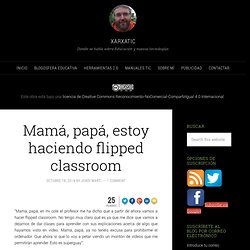

¿Conoces los 30 sitios web de vídeos educativos mas populares? Guía de RefSeek de los 25 mejores recursos online para la búsqueda de vídeos educativos gratuitos.

333377.pdf. The Best Tools and Apps for Flipped Learning Classroom. July 25, 2014 Following the posting of "Managing iPad Videos in Schools" somebody emailed me asking about some suggestions for tools and apps to create instructional videos to use in a flipped learning setting.

In fact, over the last couple of years I have reviewed several web tools and iPad apps that can be used in flipped classroom but the ones I am featuring below are among the best out there. 1- Educlipper Educlipper is a wonderful tool for creating video tutorials and guides to share with students. As a teacher you can create an Educlipper board for your class and share the link with them.
Now that you have a shared space with your students, you can go about creating instructional videos using the iPap app of Educlipper. Pixiclip is another wonderful tool to create step by step instructional videos to use in your flipped classroom. 3- Explain Everything Knowmia Teach is a new free lesson planning and recording tool for teachers and their students. 6- Educreations.
Best practices for the flipped classroom. The flipped classroom is still in its early stages, with much experimentation left to figure out the best strategies and workflows.

Fortunately for us, innovative teachers like Jon Bergmann, Aaron Sams, Crystal Kirsch, Stacey Roshan, and many many more have been paving the way and documenting their successful practices. So, teachers, what are the best practices to flip? The best ways to liberate your classroom and spend more time connecting with your students? Read on. 1) Make it student-driven Traditional classrooms are well familiar with the passive learning conundrum whereby students come to class but are not engaging in higher order thinking.
Here is the video that Carolyn made with her students: 2) Keep your videos short and interactive Jonathan Bergmann and Aaron Sams recommend keeping the videos down to 1.5 minutes per grade level. 3) Take Advantage of Your PLN. The flipped learning community is vibrant and brave teachers are always willing to share their lessons learned. Is the flipped class model here to stay? Article originally posted in edweek It's been about seven years now since Jon Bergmann and Aaron Sams set off on their journey to make the most of the limited face-to-face time with their students.

The two realized that the time the students needed them the most was when they were stuck on homework questions and needed individual help—thus the "flipped classroom" came to be. In the years since they pioneered the flipped classroom (defined in this post as delivering video lecture as a homework assignment with traditional homework done during class), it would be an understatement to say that the methodology has been polarizing. Enthusiasts believe that the flipped classroom movement is completely transforming education, while detractors believe that the technological hurdles are too formidable. So where are we right now? A recent SpeakUP survey (study here) of 403,000 educators, students, and parents found, among other results, that: Accountability is a huge challenge. Mamá, papá, estoy haciendo flipped classroom.
25 FlaresTwitter13TweetFacebook9Google+2LinkedIn1Email--Email to a friend25 Flares× “Mamá, papá, en mi cole el profesor me ha dicho que a partir de ahora vamos a hacer flipped classroom.

No tengo muy claro qué es ya que me dice que vamos a dejarnos de dar clases para aprender con sus explicaciones acerca de algo que hayamos visto en vídeo. Mamá, papá, ya no tenéis excusa para prohibirme el ordenador. Que ahora sí que lo voy a petar viendo un montón de vídeos que me permitirán aprender. Esto es superguay”. La anterior podría ser una charla bastante aproximada de chavales que llegan a sus casas desconcertados por la propuesta de su docente y que, más allá de una justificación exhaustiva (si ni tan sólo en muchas ocasiones el docente lo tiene claro), hablan acerca de cómo van a trabajar ese curso (o en algunos momentos determinados del mismo).
Fuente: La mayoría de docentes se quedan con el modelo anterior pero hay algunos que optan por un modelo avanzado. Fuente: